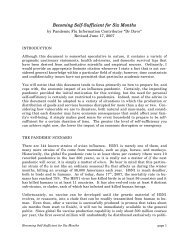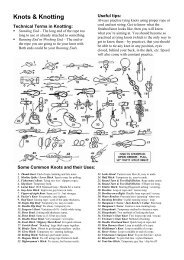( Hand to Hand: Martial Arts ) Aikido ( revised )
( Hand to Hand: Martial Arts ) Aikido ( revised )
( Hand to Hand: Martial Arts ) Aikido ( revised )
You also want an ePaper? Increase the reach of your titles
YUMPU automatically turns print PDFs into web optimized ePapers that Google loves.
English Swordsmanship<br />
"I've got a knife! Gimme your-- WHAT THE F&!@ IS THAT?!?"<br />
English Swordsmanship has a his<strong>to</strong>ry spanning thousands of years. Honed over the millenia through<br />
action against almost every invader on the European Continent, the art of the sword is highly<br />
regarded throughout English his<strong>to</strong>ry. The blades of Great Britian have been used and abused against<br />
Romans, Vikings, Normans, Picts, Germanic barbarians, Angles, Saxons, Danes, French, Spainiards,<br />
and each other. Naturally, they got very good at what they did. This form, in particular, represents the<br />
art of swordsmanship in England shortly before and in<strong>to</strong> the Renessaince (circa 1550-1600). The<br />
preferred English weapon, before the rapier came in<strong>to</strong> play, was the hand-and-a-half sword. A cutand-thrust<br />
weapon, the sword had an edge along both sides of a wide blade that slightly tapered<br />
<strong>to</strong>ward the point. The weapon had a bar-shaped crossguard that often bent outwards in the direction<br />
of the tip. Pommel shapes varied anywhere from crescents and rings <strong>to</strong> rectangular blocks and leafshapes.<br />
The weapons also tended <strong>to</strong> be very well balanced, making them feel much lighter than they<br />
look. The prime advantage <strong>to</strong> the English style of swordplay in personal combat over the thrusting<br />
style that the rest of the continent was adopting was its use in melee. The English had a tendancy <strong>to</strong><br />
use whatever worked best, so they adopted the standard combat form of swordfighting (meant for use<br />
on the battlefield) even in one-on-one duels. This provided a few advantages over the newer rapier<br />
style, mainly the quick and brutal kill as well as its natural advantages when facing more than one<br />
opponent.<br />
Modern use of this form is mostly limited <strong>to</strong> displays and SCA combat, but some have been working<br />
on res<strong>to</strong>ring it as a legitimate martial art form. It is still extremely rare, almost <strong>to</strong> the point of being an<br />
Exlcusive form (not so thanks <strong>to</strong> its use in the SCA), making teachers hard <strong>to</strong> find. Most swordsmen<br />
(and swordswomen, of course) will be forced <strong>to</strong> research the form, rather than learn it in a proper<br />
school. Still, once learned, the art is extremely effective and deadly against nearly any combatant,<br />
even with its near <strong>to</strong>tal lack of Oriental-style Internal Training.<br />
Entrance Requirements: PS and PE of 10 or higher<br />
Skill Cost: 8 Years (6 Years as a Secondary Form)<br />
Costume: English swordplay traditionally required heavy protection, running <strong>to</strong>wards full plate armor.<br />
For more reasonable clothing, a swordsman will prefer something loose that allows for full body<br />
movement, particularly in the waist and shoulders.<br />
Stance: Stands upright, knees only slightly bent, both feet in solid contact with the ground. The exact<br />
position of the primary weapon varied, but was most often held back or above the head in preperation<br />
<strong>to</strong> strike, point forward.<br />
CHARACTER BONUSES<br />
Add 2 <strong>to</strong> P.S.<br />
Add 1 <strong>to</strong> P.P.<br />
Add 2 <strong>to</strong> P.E.<br />
COMBAT SKILLS<br />
Attacks per Melee: 3<br />
Escape Moves: Roll with Punch/Fall/Impact<br />
Basic Defensive Moves: Parry, Au<strong>to</strong>matic Parry, Dodge<br />
Advanced Defenses: Disarm, Maintain Balance, Circular Parry<br />
<strong>Hand</strong> Attacks: Strike (Punch), Roundhouse (See Choy-Li-Fut Kung Fu, does 1D10 Damage),<br />
Uppercut (See Choy-Li-Fut Kung Fu, does 1D8 Damage)<br />
Basic Foot Attacks: Snap Kick, Tripping/Leg Hooks<br />
Special Attacks: False Attack(NEW! The False Attack is just that, a fake attack. It is used <strong>to</strong> draw a<br />
parry or reaction out of the opponent. The exact method of attack the character fakes varies and can<br />
be any type of attack the character possesses. This is a Combination Move, used in conjunction with
















